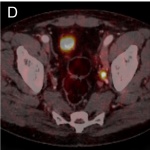
News • Radiation therapy
New gel reduces side effects of prostate cancer treatment
Radiation therapy is a popular and effective treatment for many men with prostate cancer, and now a temporary gel offers greater protection for organs at risk during treatments. “Treating prostate cancer with radiation therapy can cause unintended injury to adjacent, healthy tissue, which can lead to bowel and urinary problems, as well as erectile dysfunction,” said Daniel Krauss, M.D., a…

























